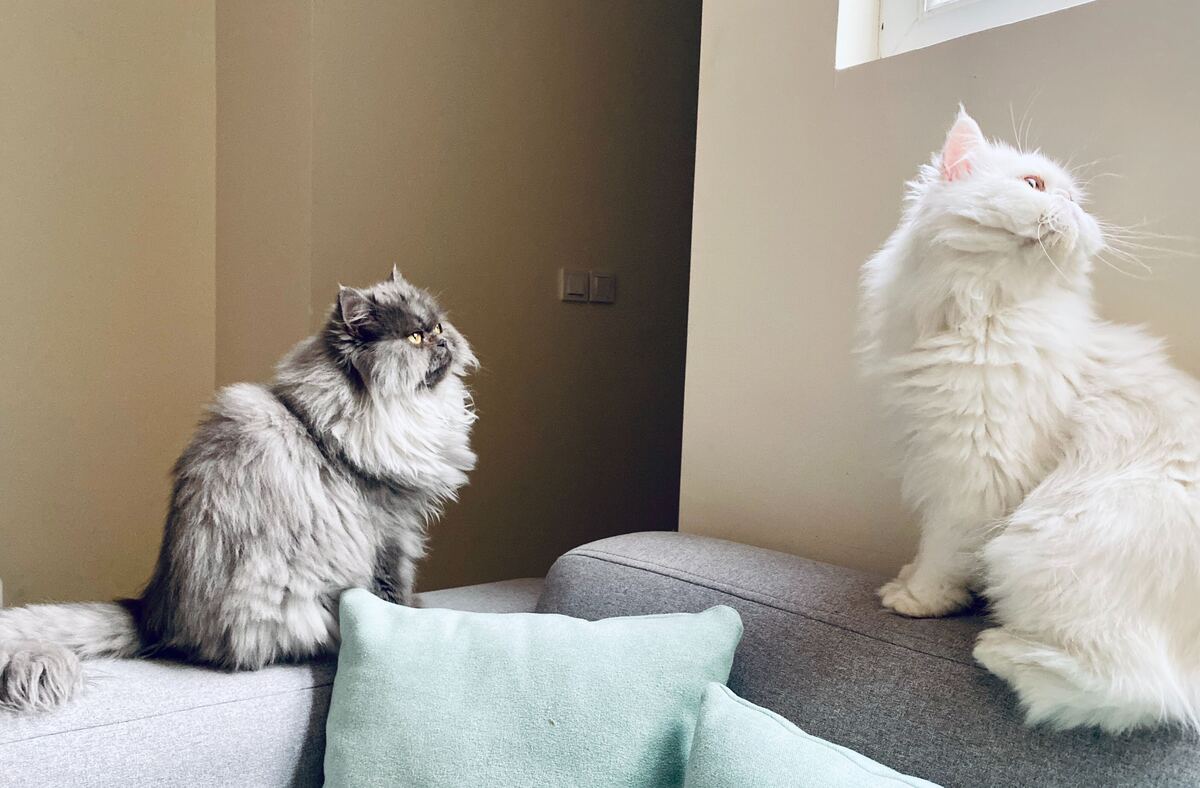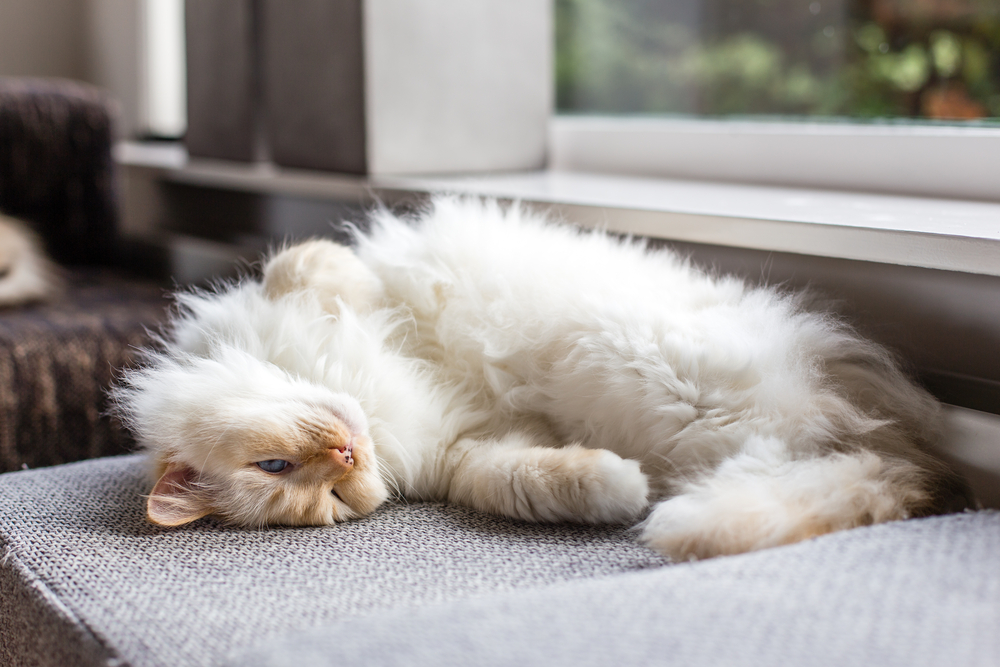📖 Table of Content:
Getting a purring pet can become quite an exciting experience when you don’t have a clue which breed to opt for. Whether you’re on the hunt for an easygoing moggy, a couch potato, or a party animal, there’s always a chance you might end up with a pet you don’t see eye to eye with. Ragdoll vs. Persian, anyone?
Granted that you have your heart set on a fluffy Ragdoll or a flat-faced Persian, know that you’re going to be surprised by the sheer number of similarities these two breeds share. Generally speaking, cats get a bad rep that they’re detached and reserved, but they’re adored because they’re “self-sufficient.”
We’d argue that most cats are, but that doesn’t mean that you’re getting a low-maintenance moggy no matter which breed you decide to go for. Persian cats are much more high-maintenance than Ragdoll cats and that’s something to consider when you’re trying to decide between the two.
When struggling to bite the bullet between two breeds that share a similar appearance, you expect them to share similar purrsonality traits, too. But that’s not the case. Before you head to the nearest breeder to get a Ragdoll or a Persian, consider your time commitment, your living situation, and your preferences.
Cats can reach a ripe age of twelve to twenty years when they’re fed, taken care of, and showered with affection. We’re pretty sure you’d be happy with both breeds, but there’s something heartbreaking about bringing home a Ragdoll cat and wondering whether a Persian would’ve been a better choice.
We suggest doing your research and getting to know both breeds better. What sets them apart? What makes them everyone’s favorite fluffers? What makes them purrfect for your family? We’re bringing you a rundown on both breeds down below.
About Ragdoll cats
A breeder by the name of Ann Baker developed the Ragdoll breed in the 1960s in Riverside, Califf. Ann was adamant about creating a cat with gorgeous, gentle, non-aggressive characteristics by breeding a semi-feral longhaired white cat resembling an Angora to cats she found or owned.
Ann’s offspring ended up with endearing temperament traits and Ann decided to name them Ragdoll cats. According to numerous sources, Ann was borrowing a black cat resembling a Persian from her neighbor for breeding – who would’ve thought there’d be a connection between the two breeds?
As time went on, Ann became obsessed with the Ragdoll breed and started spewing eccentric claims that ended up breaking apart the team that was working with her. Ann claimed that Ragdoll cats were a result of medically altered genetics even though that wasn’t the case, for example.
Breeders who were working on Ann’s team decided to continue breeding Ragdoll cats even after departing from the team. Ragdoll cats went on to become one of the most popular, prominent breeds around the world. What makes Ragdoll cats the winners of the Ragdoll vs. Persian battle?
Appearance
What makes Ragdoll cats different from the average cat? Ragdoll cats are large, lovable cats with fluffy, flowy fur and bright blue eyes – and they’re known to weigh more than an average watermelon. We’re not the ones to comment on someone’s weight, but Ragdoll cats are hefty.
Ragdoll cats can weigh anywhere between ten to twenty pounds and measure between nine to eleven inches tall and seventeen to twenty-one inches long.
Ragdoll cats are bigger than the average cat, there’s no question about that. We can’t forget that Ragdoll cats can sport black, white, gray, blue, cream, lilac, chocolate, seal, and red coat colors with colorpoint, bicolor, mitted, lynx, and tortie patterns.
Personality
We’re pretty sure that you already know that Ragdoll cats are affectionate, sweet, and adorable.
We do, however, need to underline that the reason why Ragdoll cats were named that way wasn’t because they’re doll-like or cute like dolls. Ragdoll cats are obsessed with humans and they’re known to go completely limp the moment a human picks them up – like ragdolls.
We adore these floppy cats because they’re perfect for families, great with children, and patient with fun and friendly cats that don’t take no for an answer. We’re rooting for Ragdolls, for sure.
Care
Ragdolls are the opposite of a high-maintenance breed. When you take a peep at a Ragdoll cat, you might think you’re going to spend hours and hours combing, brushing, and bathing them because they’re beaming with fluffy, flowy fur.
But that’s not the case. Before you give up on the thought of getting a Ragdoll, know that these mysterious moggies don’t come with an undercoat.
Ragdolls are big, bold, and beautiful, but they’re devoid of shedding for the most part. We suggest brushing them from time to time to prevent mats, and bathing them when you notice they’re getting greasy and stringy.
About Persian cats
Persian cats are a sight for sore eyes, but the reason why they’re one of the most accepted and adored breeds out there might be that they’re surrounded by mystery. Nobody knows exactly where and when the first Persian cat appeared. We’ve got theories aplenty, though.
Written documents suggest that Persian cats came to be around the 1500s, but these flat-faced felines might be much, much older. Cat connoisseurs managed to trace a cat that resembles the Persian back to ancient hieroglyphs.
Moving on to the 1600s, we’ve got records of exotic cats getting smuggled from Persia to Europe. By the 1800s, Persian cats reached Britain and became Queen Victoria’s protégés.
Before even earning the title “show Persians”, Persian cats were exhibited at the Crystal Palace cat show, the very first cat show. By the 1950s, selective breeding started to produce Persian cats with flatter faces and rounder heads which changed the way the OG Persian cats looked.
Appearance
Appearance-wise, Persian cats might be the winners of the Ragdoll vs. Persian battle.
With signature smooshed mouths and noses, Persian cats are different from the average cat. Whether you’re on the hunt for a breed that attracts attention or a breed that everyone knows about, you might want to opt for the Persian.
Persian cats are smaller than Ragdoll cats and they’re known to weigh between seven to thirteen pounds and measure between ten to fifteen inches tall and fifteen to eighteen inches long.
Persian cats are typically divided between two types – traditional or doll-face Persian cats and show or Peke-face Persian cats. Traditional Persian cats come with simple, sleek features and resemble the first Persian cats. Show Persian cats come with flatter faces, smaller ears, rounder heads, and fluffier furs.
Personality
Persian cats are the opposite of Ragdoll cats when we’re referring to temperament. Ragdoll cats are fun and friendly, and they’re obsessed with hanging out with humans, following them from one room to the other, and begging for attention.
Persian cats are much more calm and collected – they’re couch potatoes that prefer to nap, watch Netflix, and hang out by the window. Persian cats are affectionate and appreciative, and they’re more than happy to snuggle the day away, get massaged, petted, and rubbed, and even get picked up.
Care
When you get a purrfect pet with a teddy bear body and fluffy, flowy fur, know that you’re going to spend hours and hours combing, brushing, and bathing.
Persian cats aren’t great at grooming themselves and that’s why you need to establish a regular grooming routine the moment you bring your fashionable feline home.
We suggest combing and brushing her fur every day or every other day to prevent mats and tangles from forming and bathing her every two weeks or every time you notice her fur getting greasy and stringy.
Ragdoll vs. Persian: What sets them apart?
Ragdoll vs. Persian, what’s the verdict?
We’d argue that both breeds are freakishly alike – they’re completely, irrevocably, and unequivocally fluffy, they’re hefty, and they’re two of the most accepted and adored cat breeds on the planet. Ragdolls are large, lovable cats with luscious, luxurious coats, muscular bodies, and bright, blue eyes.
Persian cats are a little smaller than Ragdoll cats, but they’re embellished with long, lustrous coats, round, robust heads, copper, green, or blue eyes, and smooshed faces.
We’d state that the biggest difference between the two breeds when referring to appearance seems to be the face – Persian cats are born with signature flat faces that set them apart from average cats.
Whether you take a peep at a traditional Persian cat or a show Persian cat, you’re going to notice the signature features that make them stand out. Ragdoll and Persian cats aren’t all looks, though.
When addressing what sets these two beautiful breeds apart, we need to focus on what’s underneath the glitz and the glam. Persian cats are couch potatoes that tend to shy away from playing outside, running around the apartment, and playfighting.
Ragdoll cats are fun and friendly, and they’re more than happy to walk on a leash, play fetch, and learn tricks. Persian cats are more collected, calm, and delicate, and Ragdoll cats are more energetic and entertaining.
Furthermore, Ragdoll cats are incredibly intelligent and highly trainable. Persian cats are clever but they’re apathetic toward learning tricks or following commands. Ragdoll cats are oftentimes described as “dog-like” because they’re happy to do whatever you want them to do.
Finally, Persian cats are much more high-maintenance than Ragdoll cats. Persian cats require regular combing, brushing, bathing, claw clipping, and teeth cleaning because they’re unable to groom themselves due to their smushed faces.





